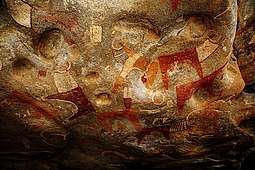Maay Maay
Mai-Mai commonly spelled Maay Maay (also known as Af-Maay, Af-Maymay, or simply Maay. The Mai-Mai spelling is rarely used but it is most often spoken.) Mai-Mai is part of the Somali language of the Cushitic branch of the Afro-Asiatic family. It is mainly spoken in Somalia and adjacent parts of Ethiopia and Kenya. In Somalia, it is widely spoken in South West state, Jubaland state and Banadir. Scholars debate whether Af-Maay is a Somali language on its own, or is one of the two main dialects that form the Somali language.
| Mai-Mai | |
|---|---|
| Af- Mai-Mai | |
| Native to | Somalia; significant communities in Ethiopia, Kenya, North America, and Yemen. |
Native speakers | 3.9 million in Somalia (2016)[1] |
| Maay alphabet (Latin script) | |
| Official status | |
Official language in | Somalia |
| Language codes | |
| ISO 639-3 | ymm |
| Glottolog | maay1238[2] |
 |
| Part of a series on the |
| Culture of Somalia |
|---|
| Culture |
| People |
| Religion |
| Language |
| Politics |
|
Overview
Somali linguistic varieties are divided into three main groups: Northern, Benadir, and Maay. Northern Somali (or Northern-Central Somali) forms the basis for Standard Somali.[3]
Maay is principally spoken by the Digil and Mirifle (Rahanweyn) clans in the southern regions of Somalia, particularly in South West.[3] Its speech area extends from the southwestern border with Ethiopia to a region close to the coastal strip between Mogadishu and Kismayo, including the city of Baidoa.[4] Maay is not mutually comprehensible with Northern Somali or Benadir, and it differs considerably in sentence structure and phonology.[5] It is also not generally used in education or media. However, Maay speakers often use Standard Somali as a lingua franca.[4] It is learned via mass communications, internal migration, and urbanisation.[5]
Grammar
Phonology
Consonants
| Bilabial | Labio- dental |
Dental | Alveolar | Palato- alveolar |
Palatal | Velar | Glottal | ||
|---|---|---|---|---|---|---|---|---|---|
| Stop | voiceless | p | t | k | ʔ | ||||
| voiced | b | d | ɡ | ||||||
| implosive | ɗ | ʼj | ɠ | ||||||
| Affricate | dʒ | ||||||||
| Fricative | β | f | ð | s | ʃ | [ɣ] | h | ||
| Nasal | m | n | ɲ | [ŋ] | |||||
| Rhotic | r | ||||||||
| Lateral | l | ||||||||
| Approximant | w | j | |||||||
A nasal consonant preceding a /n/ sound will always be realized as a [ŋ] sound. A [ɣ] sound is an intervocalic allophone of /ɡ/.[6]
Vowels
| Front | Central | Back | ||
|---|---|---|---|---|
| Close | i iː | u uː | ||
| Mid | e eː | o oː | ||
| Open | a aː | |||
Maay Maay exhibits significant amounts of epenthesis, inserting central or high-central vowels to break up consonant clusters. Vowel length is contrastive; minimal pairs such as bur 'flour' and buur 'mountain' are attested.
Words
Maay Maay is fairly agglutinative. It has complex verb forms, inflecting at least for tense/aspect and person/number of both subject and object. There is also a prefix indicating negation. In addition, verbs exhibit derivational morphology, including a causative and an applicative. Nominal morphology includes a definiteness suffix, whose form depends on the gender of the head noun, and possessive suffixes.
Sentences
Maay Maay exhibits SVO and SOV word orders, apparently in fairly free variation. When the object is postverbal, the prefix maay appears on the verb. Within the noun phrase, the head noun is generally initial. Possessors, adjectives and some strong quantifiers follow the head noun. Numerals and the indefinite quantifier precede the head noun.
References
- Mai-Mai at Ethnologue (18th ed., 2015)
- Hammarström, Harald; Forkel, Robert; Haspelmath, Martin, eds. (2017). "Maay". Glottolog 3.0. Jena, Germany: Max Planck Institute for the Science of Human History.
- Dalby (1998:571)
- Saeed, John (1999). Somali. Amsterdam: John Benjamins. p. 4. ISBN 1-55619-224-X.
- "Maay - A language of Somalia". Ethnologue. Retrieved 7 May 2013.
- Paster, Mary (2006). Aspects of Maay phonology and morphology. Pomona College.